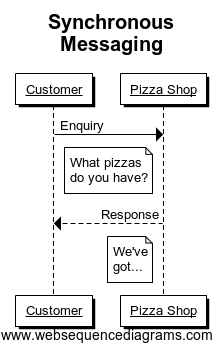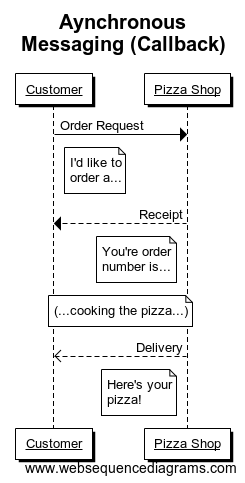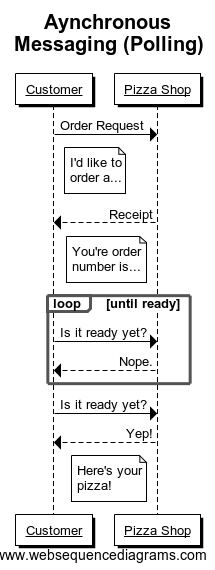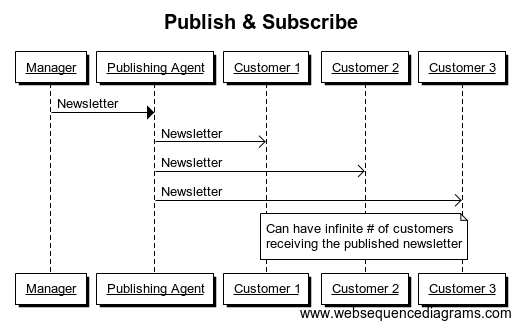This post was originally published here
December 10, 2018
First of all, I’d like to apologise to all grandmothers out there… I mean you no disrespect. It’s just meant to be a catchy title, really. I know grandmothers who are smarter than most of us.
A couple of months ago I had the privilege of speaking at the API Days event in Melbourne. My topic was on Building Event-Driven Integration Architectures, and within that talk I felt a need to compare events to messages, as Clement Vasters did so eloquently in his presentation at INTEGRATE 2018. In a slight divergence within that talk I highlighted three common messaging patterns using a pizza based analogy. Given the time constraint that segment was compressed into less than a minute, but I thought it might be valuable enough to put in a blog post.
Photo courtesy of mypizzachoice.com
1) Synchronous Messaging
 So before you can order a pizza, you need to know a couple of things. First of all, whether the pizza shop is open, and then of course what pizzas they have on offer. You really can’t do anything else without this knowledge, and those facts should be readily available – either by browsing a website, or by picking up the phone and dialling the shop. Essentially you make a request for information and that information is delivered to you straight away.
So before you can order a pizza, you need to know a couple of things. First of all, whether the pizza shop is open, and then of course what pizzas they have on offer. You really can’t do anything else without this knowledge, and those facts should be readily available – either by browsing a website, or by picking up the phone and dialling the shop. Essentially you make a request for information and that information is delivered to you straight away.
That’s what we expect with synchronous messaging – a request and response within the same channel, session and connection. And we shouldn’t have time to go get a coffee before the answer comes back. From an application perspective, that is very simple to implement as the service provider doesn’t have to initiate or establish a connection to the client; the client does all of that and service simply responds. However care must be take to ensure the response is swift, lest you risk incurring a timeout exception. Then you create ambiguity for the client who doesn’t really know whether the request was processed or not (especially troublesome if it were a transactional command that requires idempotency).
2) Asynchronous Messaging
 So now you know the store is open and what pizzas to choose from. Great. So you settle on that wonderful ham & pineapple pizza on a traditional crust with a garnish of basil, and you place your order. Now if the shopkeeper hands you a pizza straight away, you’re probably not terribly inclined to accept it. Clearly you expect your pizza to be cooked fresh to order, not just pulled ready-made off a shelf. More likely you’ll be given an order number or a ticket and told your pizza will be ready in 20 minutes or so.
So now you know the store is open and what pizzas to choose from. Great. So you settle on that wonderful ham & pineapple pizza on a traditional crust with a garnish of basil, and you place your order. Now if the shopkeeper hands you a pizza straight away, you’re probably not terribly inclined to accept it. Clearly you expect your pizza to be cooked fresh to order, not just pulled ready-made off a shelf. More likely you’ll be given an order number or a ticket and told your pizza will be ready in 20 minutes or so.
Now comes the interesting part – the delivery. Typically you will have two choices. You can either ask them to deliver the pizza to you in your home. This frees you up to do other things while you wait, and you don’t have to worry about chasing after your purchase. They bring it to you. But there’s a slight catch: you have to give them a valid address.
In the asynchronous messaging world, we would call this address a “callback” endpoint. In this scenario, the service provider has the burden of delivering the response to the client when it’s ready. This also means catering for a scenario where the callback endpoint it invalid or unavailable. Handling this could be as blunt as dropping the response and forgetting about it, or as robust as storing it and sending an out-of-band message through some alternate route to the client to come pick it up. Either way, in most cases this is an easier solution for the client than for the service provider.
But what if you don’t want to give out your address? In this case, you might say to the pizza maker, “I’ll come in and pick it up.” So they say fine, it’ll be ready in 20 minutes. Only you get there in 10 minutes and ask if it’s ready; they say not yet. You wait a few more minutes and ask again, and get the same response. Eventually it is ready and they hand you your nice fresh piping hot pizza.
This is an example of a polling pattern. The only burden on the service provider is to produce the response and then store it somewhere temporarily. The client has the job of continually asking if it is ready, and needs to cater for a series of negative responses before finally retrieving the result it is after. You might see this as a less favourable approach for the client – but sometimes this is driven by constraints on the client side, such as difficulties opening up a firewall rule to allow incoming traffic.
3) Publish & Subscribe
 Now let’s say that the pizza was so good (even if a little on the pricey side) that you decide to compliment the manager. He asks if you’d like to be notified when there are special discounts or when new pizzas are introduced. You say “Sure!” and sign up on his mailing list.
Now let’s say that the pizza was so good (even if a little on the pricey side) that you decide to compliment the manager. He asks if you’d like to be notified when there are special discounts or when new pizzas are introduced. You say “Sure!” and sign up on his mailing list.
Now the beauty of this arrangement is that it costs the manager no extra effort to have you join his mailing list. He still produces the same newsletter and publishes it through his mailing agent. The number of subscribers on the list can grow or shrink, it makes no difference. And the manager doesn’t even have to be aware of who is on that list or how many (although he/she may care if the list becomes very very short!) You as the subscriber have the flexibility to opt in or opt out.
It is precisely this flexibility and scalability that makes this pattern so attractive in the messaging world. An application can easily be extended by creating new subscribers to a message, and this is unlikely to have an impact on the existing processes that consume the same message. It is also the most decoupled solution, as the publisher and subscriber need not know anything about each other in terms of protocols, language, endpoints, etc. (except of course for the publishing endpoint which it typically distinct and isolated from either the publisher or consumer systems). This is the whole concept behind a message bus, and is the fundamental principle behind many integration and eventing platforms such as BizTalk Server and Azure Event Grid.
The challenge comes when the publisher needs to make a change, as it can be difficult sometimes to determine the impact on the subscribers, particularly when the details of those subscribers are sketchy or unknown. Most platforms come with tooling that helps with this, but if you’re designing complex applications where many different services are glued together using publish / subscribe, you will need some very good documentation and some maintenance skills to look after it.
So I hope this analogy is useful – not just for explaining to your grandmothers, but to anyone who needs to grasp the concept of messaging patterns. And now… I think I’m going to go order a pizza. ![]()





